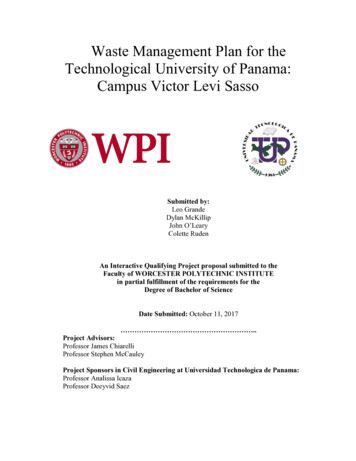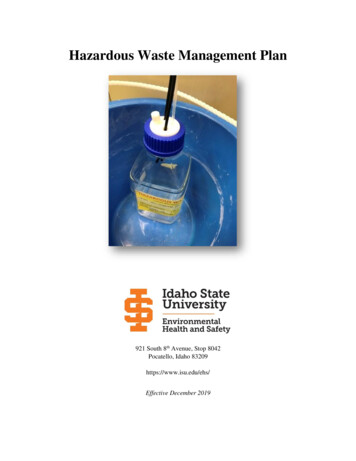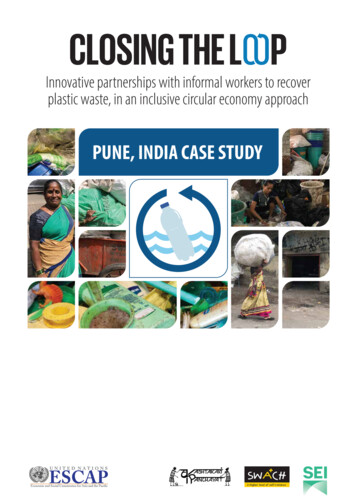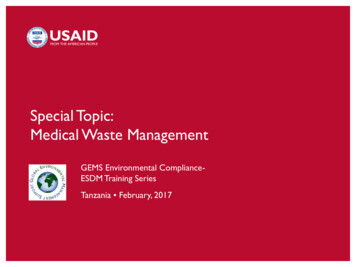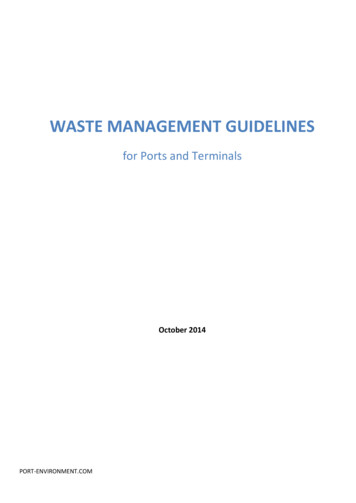
Transcription
WASTE MANAGEMENT GUIDELINESfor Ports and TerminalsOctober 2014PORT-ENVIRONMENT.COMWASTE MANAGEMENT GUIDELINES for Ports and Terminalsi
OPERATIONAL TOOLS TO SECURE EFFICIENT WASTEHANDLING IN PORTSThese Guidelines provides a framework on how to prepare a Waste Management Manual for a specificport. Development of such a port-specific waste handling manual is conducted by (i) assessing theexisting ship waste handling systems in ports/terminals (if any),and (ii) by initiating a series ofdiscussions with the port management regarding important issues for the waste management and afteragreement and final design of the waste handling system (iii)developing a Waste Management Manual,which shall include a description of the waste handling systems in the port, e.g. procedures forcollection of ship waste, waste registration and payment for services.The Manual has been partly prepared with a standard text and ready for “fill in information” in order tomake it simple for the ports and terminals. Each port or terminal can edit the Manual and take outsections that are not relevant in order to keep it short and easy to work with.It is recommended to involve the port management and all relevant stakeholders in the development ofefficient waste management system. Such stakeholders could be for example, the harbormaster,shipping agents, waste operators, refineries, various terminals, municipalities, environmental authoritiesand other government agencies.OOiiWASTE MANAGEMENT GUIDELINES for ports and terminals in Cambodia
WASTE MANAGEMENT GUIDELINES for Ports and Terminalsiii
ACRONYMS AND ABBREVIATIONSCRCargo ResiduesDWTDead WeightECEuropean CouncilEMSAEuropean Maritime Safety AgencyHFOHeavy Fuel OilIMOInternational Maritime OrganizationITInformation TechnologyIWFIndirect Waste feeMDOMarine Diesel OilMOEMINISTRY OF ENVIRONMENTMARPOLInternational Convention for the Prevention of Pollution from ShipsOWSOily Water SeparatorPWMPPort Waste Management PlanPWMMPort Waste Management ManualSGWShip Generated WasteSDSSafety Data SheetWMPWaste Management PlanWQPWater Quality ProcedureWRFWaste Registration FormWHSWaste handling systemivWASTE MANAGEMENT GUIDELINES for ports and terminals in Cambodia
DEFINITIONS Cargo residues: the remnants of any cargo material on board in cargo holds or tanks that remainafter unloading procedures and cleaning operations are completed. Dunnage: loose materials used to support and protect cargo in a ship's hold. Garbage: all kinds of domestic and operational waste generated during the normal operation of theship and liable to be disposed of continuously or periodically, except sewage. Hazardous waste: a controlled waste containing hazardous properties. This may include waste withexplosive, flammable, oxidizing, irritant, harmful, toxic, carcinogenic or corrosive properties. Passenger: any person carried in a ship except a person employed or engaged in any capacity onboard the ship on the business of the ship. Port Waste Management Plan (PWMP): is a plan describing how to implement the waste strategydecided by the port management Port Waste Management Manual (PWMM): is a manual produced by a port or terminal unifyingtheir policy on waste reception facilities for vessels and outlining all aspects of waste handling fromthe facilities available at the location, all procedures, payment systems and waste registrationrequirements. Oil: petroleum in any form including crude oil, fuel oil, sludge, oil refuse and refined products. Oily mixture: a mixture with any oil component. Operational wastes: means all cargo associated waste and maintenance waste. For this purpose,cargo associated waste means all materials which have become waste as a result of use on board aship for cargo stowage and handling and may include dunnage, shoring, pallets, lining and packingmaterials, plywood, cardboard, wire and steel strapping. Owner: the owner, charterer, manager or operator of the ship. Ship generated waste: all waste and residues that are generated during the service of a ship andwhich fall within the definitions of garbage, oil or oily mixtures, but do not include cargo residues. Ship waste: all waste, non-hazardous and hazardous, that has occurred during ship navigation, aswell as the waste being transported by cargo vessels. In general, ship waste includes solid waste andliquid waste. Solid waste: solid municipal waste (from watercraft - this waste is similar in composition todomestic waste) and ship cargo residues (residues of any type of ship cargo in ship warehouses ortanks occurred after debarking, cleaning or washing of ship warehouses, deck or tanks, includingthe excess and spilled cargo during loading/discharging operations). Liquid waste: includes waste oils (waste lubricating oil that needs to be changed periodically toensure the lubricating function of motors) and wastewaters. Wastewaters can be divided into oilyand non-oily wastewaters. Oily wastewaters originate from engine rooms and machinery spaces,e.g. pump rooms. Waste: defined as substances or objects disposed, to be disposed or required to be disposed inaccordance with the provisions of national legislation.WASTE MANAGEMENT GUIDELINES for Ports and Terminalsv
OBJECTIVE OF THE WASTE MANAGEMENT GUIDELINES“To assist ports and terminals to establish a sustainable ship waste management system in theirrespective port”.HOW TO USE THE WASTE MANAGEMENT GUIDELINESCarry out the following activities:1. Assess the existing waste handling system if any;2. Have discussions within the port and preferably with other relevant stakeholders e.g.Environmental Authorities regarding the new waste handling system; and3. Prepare the Waste Management Manual with all relevant information regarding the wastehandling system.DEVELOPMENT OF A WASTE MANAGEMENT MANUALThe Waste Management Manual shall be prepared by the port. The Port will hold overall responsibilityfor the waste handling in the port (collection and treatment of waste and compliance with nationalregulations). If the operational waste handling is contracted (outsourced) to an external waste operatorit is the obligation of the port to ensure, that the waste operator will comply with existing regulations,terms of reference and other important issues specified in his contract with the port.The port will update the Manual each time it is changed or amended and distribute the revised versionto the relevant stakeholders in and outside the port.WHO SHALL USE THE WASTE MANAGEMENT MANUALThe Waste Management Manual contains all relevant information regarding ship waste handlingnecessary to carry out safe and efficient waste handling in the port.The Manual shall therefore be distributed to all relevant stakeholders inside and outside the port e.g.vi Environmental Authorities; External waste operator(s); Relevant port staff; Harbour master; Shipping companies; Vessel operators; and Vessel staff.WASTE MANAGEMENT GUIDELINES for ports and terminals in Cambodia
WASTE MANAGEMENT GUIDELINES for Ports and Terminalsvii
1. INTRODUCTIONWaste management is the collection, transport, processing or disposal, managing and monitoring ofwaste materials. The term usually relates to materials produced by human activity, and the process isgenerally undertaken to reduce their effect on health, and the environment.The most considerable purpose of waste management plans and reception facilities is to reduce andeliminate dumping wastes illegally into the sea environment. Many examples have alreadydemonstrated that unsatisfactory waste handling and/or even illegal dumping takes place in many portsaround the world due to inefficient waste management operations, lack of control, recovery systemsand inefficient information flow. The International Convention for the Prevention of Pollution fromShips, MARPOL 73/78, and European Council Directive provide an international framework onmanagement of ship and port wastes.Waste management planning and its implementation is an important economic, environmental,technical and administrative issue for national and international agendas. As in the case of ports, portwaste management planning and its implications form a rapidly growing subject of interest in the citymanagement context. Because ports are sources of considerable volumes of valuable wastes, one of themain subjects of local authorities dealing with urban sustainable development matters is ship and portwaste management.National statutes, regulations and directives must also be aligned with regard to the strategies for theintegrated sustainable waste management of ship and port wastes. A strategy, within the legalframework, should be designed to ensure measures providing financial and operational incentives andenabling economical and environmentally successful implementation of port waste management plans.However, many ports have not met related standards yet.Ship and port waste managementrefers to the waste generated onboard and by activities in the portarea. The port waste managementmanual describes the waste streams,handling routines and provide clearinstructions for the port users.Mainly, the ports are the responsiblefor developing and implementingtheir port waste managementmanuals and plans (PWMM andPWMP). The effectiveness of thesedepends on port managementresources and procedures.WASTE MANAGEMENT GUIDELINES for Ports and Terminals1
OPERATIONAL TOOLS TOSECURE EFFICIENT WASTEHANDLING IN PORTS2WASTE MANAGEMENT GUIDELINES for ports and terminals in Cambodia
1.Assessment questionnaire2.Important issues for discussion3.Waste Management ManualPART 2WASTE MANAGEMENT GUIDELINES for Ports and Terminals3
1. INTRODUCTION AND RATIONALEThese Waste Management Guidelines focuses on how to ensure that waste generated on board vesselsis also collected by the port or delivered by the vessel crew to port reception facilities (PRF). TheGuidelines provides practical and operational tools.Experience from Europe shows that awareness about the necessity of waste collection in order toprotect the environment is a major step forward, but also that additional measures are needed toensure appropriate waste delivery. Recent studies from the European Maritime Safety Agency (EMSA)show, that if each individual port prepares their own specific Waste Management Manual on how tocollect the waste from ships (now mandatory according to the EU Directive on Port Reception Facilities),a lot of attention about waste handling will be created. Such a Manual shall also include all necessaryinformation for safe handling of the waste. For example, collection, treatment and final disposalprocedures and will therefore make it easy for all involved stakeholders, e.g. vessel crew and wasteoperators to carry out a safe waste handling.Experience from Europe also shows that the design of a “waste fee system” is a very importantparameter to have vessels to deliver their waste to port reception facilities. If a waste fee system basedon payment of an “indirect fee” (payment of a waste fee regardless of delivery) is implemented in a portor terminal, there will be no economic incentive for discharging waste into the river, as the fee for wastecollection in the port has already been paid. An indirect waste fee can be included in existing port dues(if any) or be a stand-alone fee. This, along with a clear description of procedures and increasedawareness, seems to be an efficient way to have vessels discharge waste to the PRF.Before a Waste Management Plan can be prepared for a port, it is important to have a clear picture ofthe existing situation regarding waste handling. It is recommended to carry out an assessment regardingthe existing situation using the attached questionnaire. Some issues and questions might not relevantfor all ports and can be left out of the assessment.When the assessment has been carried out, it is much easier to prepare the Port Waste ManagementManual, because the port now has all relevant facts and figures. A number of discussions within the porthave to take place to agree on the new waste handling system and it is also important that the Manualis being prepared with full support from the Port Management. The format of the Manual can vary, butthe attached format is based on waste manuals from a number of European ports. A standard text hasbeen prepared as part of the Manual, so what needs to be done, is to enter the specific information forthe port in question. If necessary, the standard text can also be changed.It is however, very important that the person(s), who drafts the Waste Management Manual carefullyreads the text and makes the necessary corrections.When the Manual has been prepared and approved by the Port Management it shall be presented anddistributed to relevant stakeholders.4WASTE MANAGEMENT GUIDELINES for ports and terminals in Cambodia
KEY STEPS LEADING TO THE PREPARATION OF APORT WASTE MANAGEMENT MANUALKey steps in the preparation of a Port Waste Management Manual and in ensuring a sustainable wastehandling system in the port:ASSESSMENT OF SHIP AND PORT WASTE HANDLINGIN PORTS AND TERMINALS1The attached questionnaire can be used for assessment of the existing ship/portwaste handling system in ports and terminals in order to have a clear pictureof the existing waste handling system and to be able to providerecommendations for improvementsISSUES FOR DISCUSSION AT THE PORT2A number of issues require a detailed discussion within the port and shall beapproved by the Port ManagementPREPARATION OF PORT WASTEMANAGEMENT MANUAL3The port shall prepare a short Port Waste Management Manual with all relevantinformation regarding waste handling in the port. In order to make it easier forports/terminal to prepare their specific PWMM, the following pre-defined inputs areprovided in the attached draft Port Waste Management Manual. These shall be seenonly as draft inputs and shall be adjusted and completed, wherever appropriate andaccording to the specific port/terminal needs.IMPLEMENTATION4When a port or terminal decides to establish a waste handling system,detailed planning is often required as the system seldom can beestablished in one day. Depending on the complexity of the port orterminal this can take from weeks to months.WASTE MANAGEMENT GUIDELINES for Ports and Terminals5
STEP 1 - ASSESSMENT OF EXISTING SHIPAND PORT WASTE MANAGEMENTSYSTEMQUESTIONNAIRE FOR THE ASSESSMENT:ASSESSMENT BY:.DATE: .PORT/TERMINAL: .PERSONS MET (name, department, and function):.Please fill in according to your best knowledge in cooperation with port/terminal managers and staffresponsible for handling ship generated waste, port waste and cargo residues).This assessment will be used in the preparation of Port Waste Management Manuals and Plans towardsfull compliance with national legislations and to ensure a modern and competitive port/terminal forwaste handling.PLEASE NOTE: All figures for liquid waste shall be quoted in liter or m3; Garbage shall be quoted in preferably kilo or m3; Figures should include all waste collected from ships within the port/terminal (all terminals withinthe port including any shipyard), both ship generated and cargo residues as well as portgenerated waste; Waste generated from other industrial activities within the port/terminal area shall be includedhere, but registered separately; Information regarding cargo residues shall most likely be obtained from terminal operators; and Regarding definition of waste types: We refer to definitions applied by MARPOL 73/78.6WASTE MANAGEMENT GUIDELINES for ports and terminals in Cambodia
1. Ship Waste and Port Waste - Actual DeliveredSHIP WASTEYear 20XXOily waste (bilge, sludge and other liquid oily waste), liter or m3Solid oily waste (sludge), kilo or m3Solid waste (domestic/household waste),garbage, kilo or m3Other waste (please specify), m3PORT WASTEOily waste, liter or mYear 20XX3Solid waste, kilo or m3Hazardous Waste, kilo or m3Other waste (please specify)2. Port/Terminal Operations and TrafficPlease state the approx. number of calls in 20XX:Vessel typeSeagoing vessel (bulk, container)No. of calls in Year 20XXExpected no. of calls 20YYFerries/passenger ships, cruise shipsTanker vesselChemical/product tanker vesselInland waterway vesselOtherPlease confirm type of port/terminal operations:TypeYes (Y) or No (N)Dry cargo bulk terminalContainer terminalChemicalsFerry/cruise/passenger terminalOil/products (loading/unloading)Other – specifyWASTE MANAGEMENT GUIDELINES for ports and terminals in Cambodia7
3. Waste Reception Facilities Available in Port/Terminal for each Port Waste TypeWho provides the OWNERSHIP of reception facilities (port/private)?FacilitiesWaste typePrivate external operatorsPortNAPortNADirect pumpingOtherOily wasteCollectionGarbageOther wasteOily wasteTreatmentGarbageOther wasteOily wasteFinal disposalGarbageOther wasteWho provides OPERATION of these facilities (operation-port/private)?FacilitiesWaste typePrivate external operatorsOily wasteCollectionGarbageOther wasteOily wasteTreatmentGarbageOther wasteOily wasteFinal disposalGarbageOther wasteMeans of collection:Please indicate/confirm waste collection method for the following waste typesWaste typeBargeTruckOily wasteGarbageOther waste(specify)8WASTE MANAGEMENT GUIDELINES for ports and terminals in Cambodia
Treatment/final disposal(Please indicate location of treatment sites)Yes (Y) or No (N)Who is in charge of operation?Facilities inside the port/terminalOily wasteGarbageOthers – specifyFacilities outside the portOily wasteGarbageOthers – specify4. Waste Registration (WR) ProcedureQuestionsDoes the port/terminal have a waste registrationsystem/formWho receives the waste registration form from calling shipsAnswersIs waste registration mandatory for all calling ships?What is the purpose of the registration form (if in place)?(please tick one or more options):- Preparation of delivery- Monitoring- Invoicing- Statistics- OtherIs any receipt issued after ship waste collection?5. Type of Waste accepted from Ships by the Port/TerminalPlease confirm types of waste accepted by the portTypeYes (Y) or No (N)Oily wasteSolid waste/GarbageOther liquid waste (specify)Other waste (please specify)WASTE MANAGEMENT GUIDELINES for ports and terminals in Cambodia9
6. Payment System in Port/Terminal (Cost Recovery/Waste Fee)PAYMENT System.Describe the system in place if any, regarding: Free of charge; What is paid for (waste types/volume)?; Who pays who?; Included in any port/terminal dues or paid separately?; Any limitation in type of waste accepted/volume?; and Other relevant info.7. Monitoring and InspectionPlease investigate if there are any systems in place for monitoring and inspection of calling shipsregarding ship waste collection.If there are (maybe national authorities) please indicate who the responsible authority is.Please provide a short description of the procedures:8. Please attach the Organization chart of the Waste Handling Unit, if any.9. Please list the name of national legislations, regulations of municipality orcurrent port/terminal regulations for the handling of ship-generated waste.No.Legislation /regulations1234567810. Other comments10WASTE MANAGEMENT GUIDELINES for ports and terminals in Cambodia
2. STEP 2 - ISSUES FOR DISCUSSION WITHINTHE PORTIndividual ports will have different approaches on how to prepare their respective WasteManagement Manual. Below is therefore listed some of the most important subjects that needclarification and discussion, before the Waste Management Manual can be prepared.Port Management supportCreation of a Port Working Group to discuss anddesign the waste handling system and preparethe Waste Management ManualDiscussion of issues such as External requirements (international and national legislation); Traffic and Waste analysis (how many ships is expected to call the port and what kind ofships; volume and type of waste expected); Policy and strategy discussions (important issues which require port managementinvolvement, such as ownership and operation of facilities); Information and communication (how do the port inform about the new waste handlingsystem); Reception facilities and procedures (which facilities are needed and how are theprocedures for the waste handling (collection/treatment/final disposal), the financialprocedures (who pays who and how much) and the administrative procedures(registration of waste to be delivered to the port reception facility); Economy (how shall the waste management system be financed (waste fee orsubsidized); and Draft the Waste Management Manual and prepare an Implementation Plan if needed(implementation plan if a long implementation period is expected).WASTE MANAGEMENT GUIDELINES for ports and terminals in Cambodia11
Have approval from Port ManagementDraft relevant documents/contractsPrepare the final Waste Management ManualPrepare Implementation Plan if needed(long implementation period/equipment/construction)Distribute to relevant stakeholder, prepare informationmeetings regarding the new system and put the WMMon the port web site12WASTE MANAGEMENT GUIDELINES for ports and terminals in Cambodia
3. STEP 3 - THE WASTE MANAGEMENTMANUALAs explained earlier in these Guidelines, the purpose of preparing the Waste Management Manual(WMM) is to provide all relevant information to everyone involved in waste management in the port orterminal.A WMM will be different for each port or terminal with different information, but the structure (format)can be the same for all ports and terminals.Therefore, a predefined structure/format for a WMM is presented below. The purpose is to make it easyfor each individual port or terminal to prepare their own specific WMM.In the predefined format presented below, the port or terminal shall read, adjust and enter the relevantinformation regarding waste handling in their respective port into the WMM.In the predefined format, there are yellow highlights, where the port or terminal shall pay specificattention.The WMM shall describe all procedures related to handling of ship waste, cargo residues and port wastein the port/terminal.The PWMM shall be precise, short and to the point.So:1. Make your assessment of the existing waste handling system in your port or terminal.2. Carry out relevant internal port discussions3. Use the pre-prepared Waste Management Manual below. Adjust and fill in the relevantinformation for your port or terminal. You can then print it out and you have your WasteManagement Manual.4. Distribute it to relevant stakeholders involved in waste management in your port or terminal.WASTE MANAGEMENT GUIDELINES for ports and terminals in Cambodia13
THE WASTE MANAGEMENT MANUALFor port/terminal:CONTENTSSection 1:Introduction, abbreviations, definitions and important notesSection 2: Contact information of all organizations involved the port or terminalwaste management system and distribution listSection 3: Overall description of the waste flow, payment system,documentation and data registrationSection 4: Waste types accepted at the portSection 5: Mandatory waste registrationSection 6: Description of the roles and responsibilities for the involvedpersons/organizationsSection 7: Description of the Service ChargesSection 8:14Standard formsWASTE MANAGEMENT GUIDELINES for ports and terminals in Cambodia
WASTE MANAGEMENT MANUAL FOR PORT OR TERMINALPrepared by:Name and positionDate:DateDistributed to:Names and organisationsWASTE MANAGEMENT GUIDELINES for ports and terminals in Cambodia15
SECTION 1:Add and revise:INTRODUCTION, ABBREVIATIONS, DEFINITIONS AND IMPORTANT NOTESIntroductionIn order to comply with National Legislation and International commitments, the Port orterminal has prepared a Waste Management Manual (WMM), which describes in details all aspects ofthe waste handling system in the port or terminal area. Waste includes ships waste, cargo residues butcan also include waste from the port or terminal.This manual applies to all vessels and its crew calling at the port or terminal, all organizations andservice providers, which are involved in the port waste handling system.The port or terminal is the main coordinator of the waste handling system and thecarrying out of enforcement functions for compliance with the requirements of the system.As required, the port or terminal prepares relevant changes and updates these in the WMM,Furthermore, the port ensures their placement on the port web site (if available) or ensures sufficientcommunication to relevant stakeholders.Important Notes In accordance with National as well as Port Regulations, the disposal of ship-generated wastesand cargo residues to reception facilities is mandatory, if the next port of call is unknown or thevolume of the ship s storage capacity is not sufficient for accumulation of the waste during thevoyage to the next port of call. The "WASTE REGISTRATION FORM" (WRF) shall be filled in by the ship master at arrival andsubmitted to the Port responsible person. For a more detailed description please refer to Section5. There are some limitations in the volume of waste accepted under the Service Charge (Section 7). Disposal of waste from a ship is available seven days a week between 7 am and 7 pm. This Manual concerns the territory and water area of the Port.16WASTE MANAGEMENT GUIDELINES for ports and terminals in Cambodia
ABBREVIATIONSCRCargo ResiduesECEuropean CouncilIMOInternational Maritime OrganisationMARPOLInternational Convention for the Prevention of Pollution from ShipsPWMPPort Waste Management PlanPWMMPort Waste Management ManualSGWShip Generated WasteWMPWaste Management PlanWRFWaste Registration FormWHSWaste handling systemWASTE MANAGEMENT GUIDELINES for ports and terminals in Cambodia17
DEFINITIONS AND EXPLANATIONS“Bilge water” means the oily water accumulated mainly in the bilge well of a ship’s machinery space."Cargo residues" shall mean the remnants of any cargo material on board in cargo holds or tanks, whichremain after unloading procedures and cleaning operations are completed.“Collection of waste” - activities associated with the receiving/disposal, accumulation and placement ofwaste in designated areas or objects, including sorting of waste for recycling or final disposal.“Garbage" - waste stored on board in garbage bins or plastic bags e.g. plastic, glass, paper, aluminumcans, ash, food waste, etc."Hazardous waste" - any harmful substances, which have such physical, chemical, biological or otherdangerous properties, which create or may create a substantial risk to the environment and humanhealth.“Liquid oily waste” - any fluid mixture containing oil residues with water and mechanical impurities,which were formed during the operation of the vessel. Such as: bilge water, waste lubricating oil, oilresidues from the fuel purification, water from the slop tanks, etc.“Penalty fee (fine)” – payment applied for all categories of ships if the irregularities of WMM areidentified."Port Waste” - waste generated inside the port area due to various kind of port operations“Port reception facilities" - any facility, which is fixed, floating or mobile and capable of receiving shipgenerated waste or cargo residues that can accumulate in vessels during their operation,“Recycling of waste” - use of waste as secondary material or energy resources."Indirect service charge" - a special service charge e.g. part of any existing port due, which shall financethe total cost of ship waste handling (collection, treatment and final disposal). The service charge is paidregardless of waste delivery (indirect).“Sewage” black and grey water“Solid oily waste” - any non-fluid oily wastes, which were formed during the operation of the vessel oroil spills (oil sludge from the cleaning of fuel and oil tanks, oily rags, sand, sawdust, oil and fuel filters,etc.)."Ship-generated waste" - all waste, including sewage, and residues other than cargo residues, whichare generated during the service of a ship and fall under the scope of Annexes I, IV and V of MARPOL73/78;"Waste operator" - a company or organisation, which performs waste collection and other sanitaryservices in accordance with the existing agreements with the Port.18WASTE MANAGEMENT GUIDELINES for ports and terminals in Cambodia
SECTION 2:Add and revise:CONTACT INFORMATIONThe following table shows the Port, Companies (e.g. waste operators) and Shipping lines/agents, whichare involved in the Waste Management Systems.PORT OR TERMINAL DEPARTMENTS CONTACT INFORMATIONCOMPANIES AND WASTE OPERATORS CONTACT INFORMATIONSHIPPING LINES/AGENTS CONTACT INFORMATIONWASTE MANAGEMENT GUIDELINES for ports and terminals in Cambodia19
SECTION 3: Add and revise:SHORT DESCRIPTIONS (MAX 10 LINES) OF THE: WASTE HANDLING SYSTEM;PAYMENT SYSTEM; ANDWASTE REGISTRATION SYSTEM.Waste Handling (recommendations can also be found in Part 1)Collection of:Oily waste: Pumped from vessel slop tank to buffer tank within the port area, to special wastecollection vessel or into drums, which are then taken to port
WASTE MANAGEMENT GUIDELINES for vPorts and Terminals DEFINITIONS Cargo residues: the remnants of any cargo material on board in cargo holds or tanks that remain after unloading procedures and cleaning operations are completed. Dunnage: loose materials used to support and protect cargo in a ship's hold. Garbage: all kinds of domestic and operational waste generated during the normal operation .



